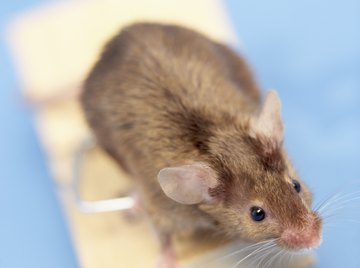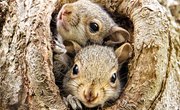
All types of rats (Rattus spp.) build nests to rear their young, which are called pups or kittens. Nests are important in helping rat mothers help her pups survive to adulthood. After mating, the male rat moves on to find another female while the pregnant female rat's maternal instincts kick in.
Rat Nest Building
Mother rats gather various materials such as twigs, grass, leaves, fabric, cardboard and paper. She shreds her materials and then packs them in a quiet, dark, hidden space that she feels will be safe from predators. When finding a suitable nest location, she will look for somewhere with easy access to food and water. The nest location should be warm and dry, and be near materials she can use to build a nest.
Rat Nest Locations
Rats have sharp teeth, so if the mother rat decides to build a nest inside a building or home, she might be in the walls, corners of storage spaces, in back of a cupboard, attic, basement, woodpiles or gutters. In the wild, Norway rats (R. norvegicus) sometimes dig small burrows to build their nests. Rats will keep the entrances of their burrows clean. The black rat (R. rattus) tends to spend more time up high, and nests may be found in trees, overgrown vines or shrubbery.
Identifying Rats Nests
Rats' nests will look a bit different depending on what the mother has used to build them. Truly Nolen describes them as looking "messy." The easiest way to identify a rat's nest, whether on the ground or up high, is by finding a trail of rat feces. Rat urine also leaves a musky smell. If the rat is indoors, quiet scratching noises may be heard while they are busy building their nest. To test whether a rat burrow is being used, stuff some newspaper or leaves down the entrance; a busy rat will clear them away in a couple of days.
Rat Development
When a mother rat, called a dam, is pregnant with her babies, she has a gestation period of between 21 and 23 days. She will typically give birth to between eight and 18 pups per litter and have up to five litters per year. Rat pups are born with their eyes closed, hairless and unable to hear. They are entirely reliant on their mother and nest to keep them warm and protected; this is called altricial. While they develop, their mother nurses them with her milk and cleans them.
After their first two weeks, rat pups open their eyes and start to move around more. Between three and four weeks old, the mother starts to wean her pups off her milk and onto solid foods. Once they can eat solid foods and fend for themselves, they can leave the nest. Rats will reach full maturity and can start breeding between three and five months of age.
Dam and Pup Pet Care
When a mother rat, or dam, has pups, she should be provided with plenty of material to shred and build a nest. Tissue paper, shredded paper, hay or paper strips are good nesting materials. According to the RSPCA, materials that break down into small fibers, fluffy bedding material, cotton wool and highly absorbent materials are not suitable as the rats may get tangled in them. If eaten, the materials may cause digestive problems, and they can cause the nest to be damp when soiled.
For at least three to seven days after she gives birth, a mother rat's cage should be kept in a tranquil place, especially if this is her first litter, so she does not get disturbed. The only disturbances should be to refill water and food. Cleaning the cage should be done with extra care when the pups are in their nest, and only if necessary within the first three days. First, the dam should be moved to a clean cage, but be warned she might resist.
While not usually territorial, the oxytocin produced when a dam gives birth makes her more likely to be aggressive towards potential intruders to protect her pups, even if this puts them all in danger. Once the dam is moved, using gloves, carefully scoop up the pups inside their nest and place them with their mother. Some dirty bedding is good to keep as it is a familiar smell for the pups and mother.
References
About the Author
Adrianne Elizabeth is a freelance writer and editor. She has a Bachelor of Science in Ecology and Biodiversity, and Marine Biology from Victoria University of Wellington in New Zealand. Driven by her love and fascination with all animals behavior and care, she also gained a Certificate in Captive Wild Animal Management from UNITEC in Auckland, New Zealand, with work experience at Wellington Zoo. Before becoming a freelance writer, Adrianne worked for many years as a Marine Aquaculture Research Technician with Plant & Food Research in New Zealand. Now Adrianne's freelance writing career focuses on helping people achieve happier, healthier lives by using scientifically proven health and wellness techniques. Adrianne is also focused on helping people better understand ecosystem functions, their importance, and how we can each help to look after them.
Photo Credits
BananaStock/BananaStock/Getty Images
